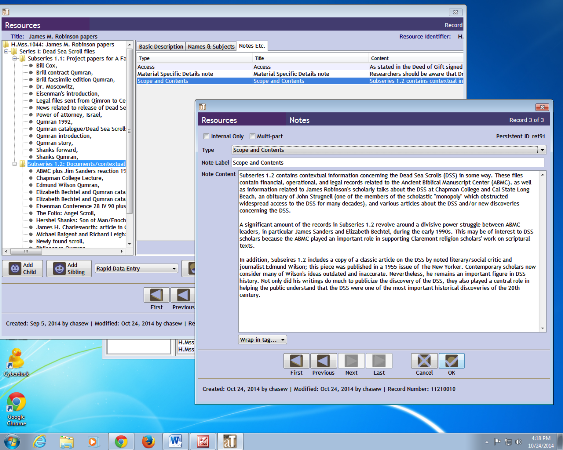This week I’ve continued to work on processing the amazing photographs and documents contained in our Nag Hammadi collection! In addition, I’ve completed a bit more work on the Dead Sea Scrolls files. Specifically, I have created something called “scope and content” notes for each series and subseries in the collection. In this week’s blog post, I thought it might be helpful for me to explain the purpose of these notes, and also to introduce everyone to the closely related concept of a “finding aid.”
In brief, a scope and content note is a prose paragraph(s) telling the researcher “the range and topical coverage of the described materials, often mentioning the form and arrangement of the materials and naming significant organizations, individuals, events, places, and subjects represented. The purpose of this scope and content note is to assist readers in evaluating the potential relevance of the materials to their research. It may highlight particular strengths of, or gaps in, the described information entered in other parts of the finding aid” (many thanks to my erudite Honnold/Mudd supervisor, Lisa Crane, for this excellent explanation).
If you’re a researcher, one of the first things you’ll want to do when you’re in an archive is examine the scope and content note(s) for a collection in which you’re interested. These can save you a ton of time, because they’ll clue you in fast and early to the contents of a particular grouping of documents. If there’s nothing useful to your work there, you know it would be more productive for you to move on and spend your time elsewhere.
So what do these notes actually look like? To help orient you, I’ve taken a couple of screenshots of the ones I designed today. You’ll notice I’ve already entered them in Archivist Toolkit. Here’s an image of the Series-level Dead Sea Scroll scope and content note:

If you want to get even more detailed, you can then proceed to investigate one of the Subseries-level scope and content notes, which look like this:

Does that make sense? I hope so! With this in mind, then, it’s possible for us to learn more about what a finding aid is. You can think about a finding aid as a much more detailed version of a scope and content note. People have created these for centuries in order to try and help make vast quantities of documents more manageable to sift through (think about how important that would be in the pre-digital world!). In fact, there is even evidence that the ancient Sumerians carved finding aids into clay tablets so that they could easily locate important bureaucratic records (http://thediscoverblog.com/2012/02/28/discover-finding-aids/)!
Finding aids will often contain a significant amount of background information, such as a biography of the documents’ creator, a historical chronology of important events which relate to the collection, etc. This can help a researcher contextualize the records s/he will find if they choose to study a particular group of records. The finding aid will also probably explain how the collection is organized, and perhaps even contain a detailed overview of the materials it includes. A good archivist will normally create a finding aid in the course of processing a collection. Indeed, this is usually the final step in processing, because by then the records will have been properly conserved and arranged in their final order, and the archivist will be quite familiar with the contents of the entire collection.
If you’re interested in doing archival research anytime soon, I urge you to become comfortable reading scope and contents notes, and in using finding aids. Even the best-organized archive will look like a vast and chaotic sea of records without them! On that note, here’s a great finding aid tutorial created by San Diego State University Library. You may wish to explore it – http://library.sdsu.edu/guides/tutorial.php?id=8&pid=30.
Enjoy!